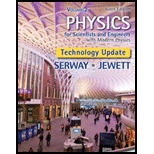
Concept explainers
A 200-kg object and a 500-kg object are separated by 4.00 m. (a) Find the net gravitational force exerted by these objects on a 50.0-kg object placed midway between them. (b) At what position (other than an infinitely remote one) can the 50.0-kg object be placed so as to experience a net force of zero from the other two objects?
(a)
The net gravitational field exerted on the object.
Answer to Problem 13.3P
The net gravitational field exerted on the object is
Explanation of Solution
Given info: The mass of the first object is
The universal gravitational constant is
The third object is at the midpoint of the distance between the first object and the second object.
The formula for gravitational force is,
Here,
For first object and third object
Substitute
The force by the first object on third object is
For second object and third object
Substitute
The force by the second object on third object is
The expression for the net force on the third object is,
The direction of the forces by first and second object on the third object is opposite to each other.
Substitute
Conclusion:
Therefore, the net gravitational field exerted on the object is
(b)
The position at which the net force on the object is zero.
Answer to Problem 13.3P
The net force on the object is zero at a distance of
Explanation of Solution
Given info: The mass of the first object is
The expression for the distance of the third object from the first object is,
Here,
For first object and third object
Substitute
Substitute
For second object and third object
Substitute
The expression for the net force on the third object is,
The direction of the forces by first and second object on the third object is opposite to each other.
Substitute
Rearrange the above equation for value of
Conclusion:
Therefore, the net force on the object is zero at a distance of
Want to see more full solutions like this?
Chapter 13 Solutions
Physics For Scientists And Engineers, Volume 2, Technology Update
- The gravitational force exerted on an astronaut on the Earths surface is 650 N directed downward. When she is in the space station in orbit around the Earth, is the gravitational force on her (a) larger, (b) exactly the same, (c) smaller, (d) nearly but not exactly zero, or (e) exactly zero?arrow_forwardEstimate the gravitational force between two sumo wrestlers, with masses 220 kg and 240 kg, when they are embraced and their centers are 1.2 m apart.arrow_forwardA point mass m is located a distance D from the nearest end of a thin rod of mass M and length L along the axis of the rod. Find the gravitational force exerted on the point mass by the rod.arrow_forward
- A satellite of mass 16.7 kg in geosynchronous orbit at an altitude of 3.58 104 km above the Earths surface remains above the same spot on the Earth. Assume its orbit is circular. Find the magnitude of the gravitational force exerted by the Earth on the satellite. Hint: The answer is not 163 N.arrow_forwardIn the law of universal gravitation, Newton assumed that the force was proportional to the product of the two masses (m1m2) . While all scientific conjectures must be experimentally verified, can you provided arguments as to why this must be? (You may wish to consider simple examples in which any other form would lead to contradictory results.)arrow_forwardThe Sun has a mass of approximately 1.99 1030 kg. a. Given that the Earth is on average about 1.50 1011 m from the Sun, what is the magnitude of the Suns gravitational field at this distance? b. Sketch the magnitude of the gravitational field due to the Sun as a function of distance from the Sun. Indicate the Earths position on your graph. Assume the radius of the Sun is 7.00 108 m and begin the graph there. c. Given that the mass of the Earth is 5.97 1024 kg, what is the magnitude of the gravitational force on the Earth due to the Sun?arrow_forward
- Let gM represent the difference in the gravitational fields produced by the Moon at the points on the Earths surface nearest to and farthest from the Moon. Find the fraction gM/g, where g is the Earths gravitational field. (This difference is responsible for the occurrence of the lunar tides on the Earth.)arrow_forwardA space station, in the form of a wheel 120 m in diameter, rotates to provide an artificial gravity of 3.00 m/s2 for persons who walk around on the inner wall of the outer rim. Find the rate of the wheels rotation in revolutions per minute that will produce this effect.arrow_forwardA planet has two moons with identical mass. Moon 1 is in a circular orbit of radius r. Moon 2 is in a circular orbit of radius 2r. The magnitude of the gravitational force exerted by the planet on Moon 2 is (a) four times as large (b) twice as large (c) the same (d) half as large (e) one-fourth as large as the gravitational force exerted by the planet on Moon 1.arrow_forward
 Principles of Physics: A Calculus-Based TextPhysicsISBN:9781133104261Author:Raymond A. Serway, John W. JewettPublisher:Cengage Learning
Principles of Physics: A Calculus-Based TextPhysicsISBN:9781133104261Author:Raymond A. Serway, John W. JewettPublisher:Cengage Learning Physics for Scientists and Engineers, Technology ...PhysicsISBN:9781305116399Author:Raymond A. Serway, John W. JewettPublisher:Cengage Learning
Physics for Scientists and Engineers, Technology ...PhysicsISBN:9781305116399Author:Raymond A. Serway, John W. JewettPublisher:Cengage Learning Glencoe Physics: Principles and Problems, Student...PhysicsISBN:9780078807213Author:Paul W. ZitzewitzPublisher:Glencoe/McGraw-Hill
Glencoe Physics: Principles and Problems, Student...PhysicsISBN:9780078807213Author:Paul W. ZitzewitzPublisher:Glencoe/McGraw-Hill University Physics Volume 1PhysicsISBN:9781938168277Author:William Moebs, Samuel J. Ling, Jeff SannyPublisher:OpenStax - Rice University
University Physics Volume 1PhysicsISBN:9781938168277Author:William Moebs, Samuel J. Ling, Jeff SannyPublisher:OpenStax - Rice University College PhysicsPhysicsISBN:9781305952300Author:Raymond A. Serway, Chris VuillePublisher:Cengage Learning
College PhysicsPhysicsISBN:9781305952300Author:Raymond A. Serway, Chris VuillePublisher:Cengage Learning Physics for Scientists and Engineers: Foundations...PhysicsISBN:9781133939146Author:Katz, Debora M.Publisher:Cengage Learning
Physics for Scientists and Engineers: Foundations...PhysicsISBN:9781133939146Author:Katz, Debora M.Publisher:Cengage Learning





